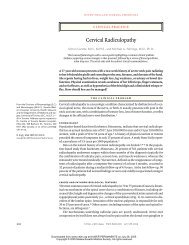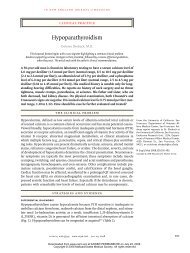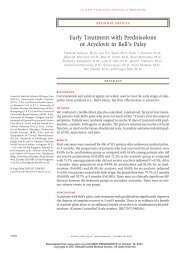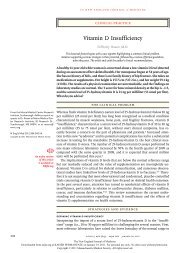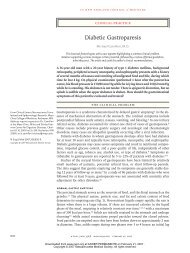Hypertension in Pregnancy 2011.pdf
Hypertension in Pregnancy 2011.pdf
Hypertension in Pregnancy 2011.pdf
You also want an ePaper? Increase the reach of your titles
YUMPU automatically turns print PDFs into web optimized ePapers that Google loves.
T h e n e w e ngl a nd j o u r na l o f m e dic i n e<br />
cl<strong>in</strong>ical practice<br />
Chronic <strong>Hypertension</strong> <strong>in</strong> <strong>Pregnancy</strong><br />
Ellen W. Seely, M.D., and Jeffrey Ecker, M.D.<br />
This Journal feature beg<strong>in</strong>s with a case vignette highlight<strong>in</strong>g a common cl<strong>in</strong>ical problem.<br />
Evidence support<strong>in</strong>g various strategies is then presented, followed by a review of formal guidel<strong>in</strong>es,<br />
when they exist. The article ends with the authors’ cl<strong>in</strong>ical recommendations.<br />
A 35-year-old woman who has never been pregnant and who has a 5-year history of hypertension<br />
wants to become pregnant. She has stopped us<strong>in</strong>g contraception. Her only<br />
medication is lis<strong>in</strong>opril at a dose of 10 mg per day. Her blood pressure is 124/68 mm Hg,<br />
and her body-mass <strong>in</strong>dex (the weight <strong>in</strong> kilograms divided by the square of the height<br />
<strong>in</strong> meters) is 27. What would you advise?<br />
The Cl<strong>in</strong>ic a l Problem<br />
Chronic hypertension <strong>in</strong> pregnancy is def<strong>in</strong>ed as a blood pressure of at least 140 mm Hg<br />
systolic or 90 mm Hg diastolic pressure before pregnancy or, for women who first<br />
present for care dur<strong>in</strong>g pregnancy, before 20 weeks of gestation. The prevalence of<br />
chronic hypertension <strong>in</strong> pregnancy <strong>in</strong> the United States is estimated to be as high<br />
as 3% 1 and has been <strong>in</strong>creas<strong>in</strong>g over time. This <strong>in</strong>crease <strong>in</strong> prevalence is primarily<br />
attributable to the <strong>in</strong>creased prevalence of obesity, a major risk factor for hypertension,<br />
as well as the delay <strong>in</strong> childbear<strong>in</strong>g to ages when chronic hypertension is more common.<br />
Therefore, an <strong>in</strong>creas<strong>in</strong>g number of women enter pregnancy with hypertension<br />
and need both counsel<strong>in</strong>g regard<strong>in</strong>g the risks of chronic hypertension <strong>in</strong> pregnancy<br />
and adjustment of antihypertensive treatment before and dur<strong>in</strong>g pregnancy.<br />
Most women with chronic hypertension have good pregnancy outcomes, but these<br />
women are at <strong>in</strong>creased risk for pregnancy complications, as compared with the<br />
general population. The risk of an adverse outcome <strong>in</strong>creases with the severity of<br />
hypertension and end-organ damage. 2 Furthermore, some antihypertensive agents<br />
carry risks <strong>in</strong> pregnancy and should be discont<strong>in</strong>ued before conception. 3 S<strong>in</strong>ce<br />
nearly 50% of pregnancies <strong>in</strong> the United States are unplanned, 4 it is important to<br />
counsel women of reproductive age who have hypertension regard<strong>in</strong>g such risks<br />
as part of rout<strong>in</strong>e care.<br />
Women with chronic hypertension have an <strong>in</strong>creased frequency of preeclampsia<br />
(17 to 25%, 1,5,6 vs. 3 to 5% <strong>in</strong> the general population), as well as placental abruption,<br />
fetal growth restriction, preterm birth, and cesarean section. The risk of superimposed<br />
preeclampsia <strong>in</strong>creases with an <strong>in</strong>creas<strong>in</strong>g duration of hypertension. 2 Preeclampsia<br />
is a lead<strong>in</strong>g cause of preterm birth and cesarean delivery <strong>in</strong> this population. 6,7 In a<br />
study <strong>in</strong>volv<strong>in</strong>g 861 women with chronic hypertension, preeclampsia developed <strong>in</strong><br />
22%, and the condition occurred <strong>in</strong> nearly half these women at less than 34 weeks of<br />
gestation, earlier than is typical <strong>in</strong> women without antecedent hypertension. Women<br />
with chronic hypertension with superimposed preeclampsia are at <strong>in</strong>creased risk for<br />
giv<strong>in</strong>g birth to an <strong>in</strong>fant who is small for gestational age 6 and for placental abruption,<br />
as compared with women with chronic hypertension without superimposed<br />
preeclampsia.<br />
From the Endocr<strong>in</strong>ology, Diabetes, and<br />
<strong>Hypertension</strong> Division, Brigham and<br />
Women’s Hospital (E.W.S.); Harvard<br />
Medical School (E.W.S., J.E.); and the<br />
Maternal–Fetal Medic<strong>in</strong>e Division, Massachusetts<br />
General Hospital (J.E.) — all<br />
<strong>in</strong> Boston. Address repr<strong>in</strong>t requests to<br />
Dr. Seely at the Division of Endocr<strong>in</strong>ology,<br />
Diabetes, and <strong>Hypertension</strong>, Brigham<br />
and Women’s Hospital, 221 Longwood<br />
Ave., Boston, MA 02115, or at eseely@<br />
partners.org.<br />
N Engl J Med 2011;365:439-46.<br />
Copyright © 2011 Massachusetts Medical Society.<br />
An audio version<br />
of this article<br />
is available at<br />
NEJM.org<br />
n engl j med 365;5 nejm.org august 4, 2011 439<br />
The New England Journal of Medic<strong>in</strong>e<br />
Downloaded from nejm.org at KAISER PERMANENTE on August 4, 2011. For personal use only. No other uses without permission.<br />
Copyright © 2011 Massachusetts Medical Society. All rights reserved.
T h e n e w e ngl a nd j o u r na l o f m e dic i n e<br />
Even <strong>in</strong> the absence of superimposed preeclampsia,<br />
women with chronic hypertension have an <strong>in</strong>creased<br />
risk of adverse outcomes. 5 Studies that were<br />
performed <strong>in</strong> Canada, the United States, and New<br />
Zealand have <strong>in</strong>dicated that fetal growth restriction<br />
(estimated or actual fetal weight,
cl<strong>in</strong>ical pr actice<br />
Table 1. Common Pharmacologic Therapies for Chronic <strong>Hypertension</strong> <strong>in</strong> <strong>Pregnancy</strong>.*<br />
Drug<br />
Methyldopa<br />
Labetalol<br />
Class or Mechanism<br />
of Action Usual Range of Dose Comments<br />
Centrally act<strong>in</strong>g alpha<br />
agonist<br />
Comb<strong>in</strong>ed alpha- and<br />
beta-blocker<br />
250 mg to 1.5 g orally twice<br />
daily<br />
Often used as first-l<strong>in</strong>e therapy<br />
Long-term data suggest safety<br />
<strong>in</strong> offspr<strong>in</strong>g<br />
100–1200 mg orally twice daily Often used as first-l<strong>in</strong>e therapy<br />
May exacerbate asthma<br />
Intravenous formulation is<br />
available to treat hyper -<br />
tensive emergencies<br />
Metoprolol Beta-blocker 25–200 mg orally twice daily May exacerbate asthma<br />
Possible association with fetal<br />
growth restriction<br />
Other beta-blockers (e.g., p<strong>in</strong>dolol<br />
and propranolol) have<br />
been safely used<br />
Some experts recommend avoid<strong>in</strong>g<br />
atenolol<br />
Nifedip<strong>in</strong>e (longact<strong>in</strong>g)<br />
Calcium-channel<br />
blocker<br />
Hydralaz<strong>in</strong>e Peripheral vasodilator 50–300 mg orally <strong>in</strong> two or four<br />
divided doses<br />
30–120 mg orally once daily Use of short-act<strong>in</strong>g nifedip<strong>in</strong>e<br />
is typically not recommended,<br />
given risk of hypotension<br />
Other calcium-channel blockers<br />
have been safely used<br />
Intravenous formulation is available<br />
to treat hypertensive<br />
emergencies<br />
Hydrochlorothiazide Diuretic 12.5–50 mg orally once daily Previous concerns about <strong>in</strong>creased<br />
risk of an adverse<br />
outcome are not supported<br />
by recent data<br />
* The use of angiotens<strong>in</strong>-convert<strong>in</strong>g–enzyme <strong>in</strong>hibitors or angiotens<strong>in</strong>-receptor blockers is contra<strong>in</strong>dicated <strong>in</strong> pregnancy<br />
because of the risk of birth defects and fetal or neonatal renal failure.<br />
<strong>in</strong>clud<strong>in</strong>g 28 randomized trials compar<strong>in</strong>g antihypertensive<br />
treatment either with placebo or with<br />
no treatment showed that antihypertensive treatment<br />
significantly reduced the risk of severe hypertension.<br />
However, treatment did not reduce the<br />
risks of superimposed preeclampsia, placental abruption,<br />
or growth restriction, nor did it improve<br />
neonatal outcomes. 13<br />
The antihypertensive agent with the largest<br />
quantity of data regard<strong>in</strong>g fetal safety is methyldopa,<br />
which has been used dur<strong>in</strong>g pregnancy s<strong>in</strong>ce<br />
the 1960s. In one study, 16 no adverse developmental<br />
outcomes were reported dur<strong>in</strong>g 7.5 years of<br />
follow-up among 195 children whose mothers had<br />
received methyldopa. Thus, methyldopa is considered<br />
to be a first-l<strong>in</strong>e therapy <strong>in</strong> pregnancy by<br />
many guidel<strong>in</strong>e groups. 17-19 However, methyldopa<br />
frequently causes somnolence, which may limit its<br />
tolerability and necessitate the use of other agents.<br />
In a meta-analysis of randomized trials compar<strong>in</strong>g<br />
different antihypertensive agents <strong>in</strong> pregnancy,<br />
the use of beta-blockers resulted <strong>in</strong> fewer episodes<br />
of severe hypertension than the use of methyldopa.<br />
13 Labetalol, a comb<strong>in</strong>ed alpha- and beta-receptor<br />
blocker, is often recommended as another firstl<strong>in</strong>e<br />
18 or second-l<strong>in</strong>e 17 therapy for hypertension <strong>in</strong><br />
pregnancy. Although some data have suggested an<br />
association between atenolol and fetal growth restriction,<br />
20 this f<strong>in</strong>d<strong>in</strong>g has not been reported with<br />
the use of other beta-blockers or labetalol, and<br />
whether the observed association was attributable<br />
to the use of atenolol or to the underly<strong>in</strong>g<br />
hypertension is uncerta<strong>in</strong>. Nonetheless, some experts<br />
consider it prudent to avoid the use of atenolol<br />
dur<strong>in</strong>g pregnancy. 18<br />
Long-act<strong>in</strong>g calcium-channel blockers also appear<br />
to be safe <strong>in</strong> pregnancy, although experience<br />
is more limited than with labetalol. 21 Diuretics<br />
were long considered contra<strong>in</strong>dicated <strong>in</strong> pregnancy<br />
because of concern about volume depletion. However,<br />
a review of n<strong>in</strong>e randomized trials showed<br />
no significant difference <strong>in</strong> pregnancy outcomes<br />
n engl j med 365;5 nejm.org august 4, 2011 441<br />
The New England Journal of Medic<strong>in</strong>e<br />
Downloaded from nejm.org at KAISER PERMANENTE on August 4, 2011. For personal use only. No other uses without permission.<br />
Copyright © 2011 Massachusetts Medical Society. All rights reserved.
T h e n e w e ngl a nd j o u r na l o f m e dic i n e<br />
among women with hypertension who took diuretics<br />
and those who took no antihypertensive medication.<br />
22 Accord<strong>in</strong>gly, some guidel<strong>in</strong>es support the<br />
cont<strong>in</strong>uation of diuretic therapy dur<strong>in</strong>g pregnancy<br />
<strong>in</strong> women with chronic hypertension who were<br />
previously treated with these agents. 17,18<br />
Angiotens<strong>in</strong>-convert<strong>in</strong>g–enzyme (ACE) <strong>in</strong>hibitors<br />
and angiotens<strong>in</strong>-receptor blockers (ARBs) are<br />
contra<strong>in</strong>dicated <strong>in</strong> pregnancy. Their use <strong>in</strong> the second<br />
half of pregnancy has been associated with<br />
oligohydramnios (probably result<strong>in</strong>g from impaired<br />
fetal renal function) and neonatal anuria, growth<br />
abnormalities, skull hypoplasia, and fetal death. 23-26<br />
ACE <strong>in</strong>hibitors have also been associated with potential<br />
teratogenic effects. In a retrospective cohort<br />
study that <strong>in</strong>cluded women who had been exposed<br />
to ACE <strong>in</strong>hibitors <strong>in</strong> the first trimester, the risk<br />
ratio associated with exposure to ACE <strong>in</strong>hibitors,<br />
as compared with exposure to other antihypertensive<br />
agents, was 4.0 (95% confidence <strong>in</strong>terval<br />
[CI], 1.9 to 7.3) for cardiovascular defects and 5.5<br />
(95% CI, 1.7 to 17.6) for central-nervous-system<br />
defects. 3 Although the observational nature of the<br />
study makes it impossible to rule out confound<strong>in</strong>g<br />
by other factors associated with the use of ACE<br />
<strong>in</strong>hibitors, it is recommended that women tak<strong>in</strong>g<br />
ACE <strong>in</strong>hibitors and, by extrapolation, other blockers<br />
of the ren<strong>in</strong>–angiotens<strong>in</strong> system (e.g., ARBs and<br />
ren<strong>in</strong> <strong>in</strong>hibitors) be switched to another antihypertensive<br />
class of drugs before conception whenever<br />
possible.<br />
Lifestyle modifications, <strong>in</strong>clud<strong>in</strong>g weight reduction<br />
and <strong>in</strong>creased physical activity, have been<br />
shown to improve blood-pressure control <strong>in</strong> persons<br />
who are not pregnant. In addition, an <strong>in</strong>creased<br />
body-mass <strong>in</strong>dex is a well-established risk<br />
factor for preeclampsia. 27 The American College<br />
of Obstetrics and Gynecology recommends weight<br />
reduction before pregnancy <strong>in</strong> obese women. 28<br />
However, data are lack<strong>in</strong>g to <strong>in</strong>form whether such<br />
measures improve pregnancy outcomes specifically<br />
<strong>in</strong> women with hypertension.<br />
Blood-Pressure Goals <strong>in</strong> <strong>Pregnancy</strong><br />
In the absence of conclusive data from randomized<br />
trials to guide thresholds for <strong>in</strong>itiat<strong>in</strong>g the use<br />
of antihypertensive medications or blood-pressure<br />
targets <strong>in</strong> pregnancy, various professional guidel<strong>in</strong>es<br />
provide disparate recommendations regard<strong>in</strong>g<br />
<strong>in</strong>dications for start<strong>in</strong>g therapy (rang<strong>in</strong>g from<br />
a blood pressure of >159/89 mm Hg 14,17,29 to one<br />
of >169/109 mm Hg 18,19 ) and for blood-pressure<br />
targets for women who are receiv<strong>in</strong>g therapy (rang<strong>in</strong>g<br />
from
cl<strong>in</strong>ical pr actice<br />
ilar results for the detection of growth restriction, 36<br />
ultrasonography also assesses amniotic-fluid volume<br />
and fetal movements and tone (biophysical<br />
profile), evaluations that may be useful with respect<br />
to the risks associated with chronic hypertension<br />
<strong>in</strong> pregnancy.<br />
Given the <strong>in</strong>creased risk of stillbirth <strong>in</strong> mothers<br />
with hypertension, 10 surveillance of fetal wellbe<strong>in</strong>g<br />
is also recommended by some experts, although<br />
others recommend restrict<strong>in</strong>g such test<strong>in</strong>g<br />
to pregnancies with complications, such as growth<br />
restriction or preeclampsia. 17,18 Test<strong>in</strong>g may also<br />
<strong>in</strong>clude the evaluation of the pattern and variability<br />
of the fetal heart rate (nonstress test<strong>in</strong>g). Maternal<br />
complications (e.g., preeclampsia or worsen<strong>in</strong>g<br />
hypertension), nonreassur<strong>in</strong>g fetal-test<strong>in</strong>g<br />
results, or concern about fetal growth restriction<br />
are often <strong>in</strong>dications for early delivery. Cl<strong>in</strong>icians<br />
must weigh the risks of fetal morbidity associated<br />
with delivery before term aga<strong>in</strong>st the risks of maternal<br />
and fetal complications from cont<strong>in</strong>ued expectant<br />
management. In women with chronic<br />
hypertension without additional complications,<br />
delivery is often planned near the estimated due<br />
date, although the need for such <strong>in</strong>tervention is<br />
uncerta<strong>in</strong> if test<strong>in</strong>g results are reassur<strong>in</strong>g and fetal<br />
growth is normal.<br />
Breast-feed<strong>in</strong>g<br />
Breast-feed<strong>in</strong>g should be encouraged <strong>in</strong> women<br />
with chronic hypertension, <strong>in</strong>clud<strong>in</strong>g those requir<strong>in</strong>g<br />
medication. Although most antihypertensive<br />
agents can be detected <strong>in</strong> breast milk, levels are<br />
generally lower than those <strong>in</strong> maternal plasma. 37<br />
These relatively low levels and observational data<br />
from series of women who were receiv<strong>in</strong>g medications<br />
while breast-feed<strong>in</strong>g have led the American<br />
Academy of Pediatrics to label most antihypertensive<br />
agents, <strong>in</strong>clud<strong>in</strong>g ACE <strong>in</strong>hibitors, as “usually<br />
compatible” with breast-feed<strong>in</strong>g. 38 S<strong>in</strong>ce case reports<br />
have described lethargy and bradycardia <strong>in</strong><br />
newborns who are breast-fed by mothers tak<strong>in</strong>g<br />
atenolol, the American Academy of Pediatrics recommends<br />
that atenolol be used “with caution.” No<br />
such cautions are noted for other beta-blockers,<br />
such as metoprolol. Because data are lack<strong>in</strong>g with<br />
respect to the use of ARBs and breast-feed<strong>in</strong>g, it is<br />
recommended that other agents be considered for<br />
treat<strong>in</strong>g hypertension <strong>in</strong> lactat<strong>in</strong>g women. Recommendations<br />
from the Society of Obstetricians and<br />
Gynaecologists of Canada note that the use of<br />
long-act<strong>in</strong>g nifedip<strong>in</strong>e, labetalol, methyldopa, captopril,<br />
and enalapril is acceptable dur<strong>in</strong>g breastfeed<strong>in</strong>g.<br />
21<br />
A r e a s of Uncerta <strong>in</strong> t y<br />
Data from randomized trials to <strong>in</strong>form the treatment<br />
of women with chronic hypertension <strong>in</strong> pregnancy<br />
are limited, <strong>in</strong>clud<strong>in</strong>g whether women with<br />
mild-to-moderate hypertension should receive antihypertensive<br />
treatment, which target blood pressure<br />
should be used for treatment, and which<br />
antihypertensive agents are superior for use <strong>in</strong><br />
pregnancy. The Control of <strong>Hypertension</strong> <strong>in</strong> <strong>Pregnancy</strong><br />
Study (CHIPS; Cl<strong>in</strong>icalTrials.gov number,<br />
NCT01192412) is an ongo<strong>in</strong>g randomized trial <strong>in</strong>volv<strong>in</strong>g<br />
women with chronic hypertension or pregnancy-associated<br />
hypertension that is compar<strong>in</strong>g<br />
“less tight” control (target diastolic blood pressure,<br />
100 mm Hg) with “tight” control (target diastolic<br />
blood pressure, 85 mm Hg) with respect to maternal,<br />
fetal, and neonatal outcomes 39 ; study completion<br />
is anticipated <strong>in</strong> 2013. Additional prospective<br />
studies are needed to assess maternal and fetal<br />
outcomes associated with the use of different antihypertensive<br />
therapies and blood-pressure targets.<br />
Long-term follow-up of both mother and offspr<strong>in</strong>g<br />
is also warranted, particularly given the <strong>in</strong>creas<strong>in</strong>g<br />
evidence that the environment <strong>in</strong> utero <strong>in</strong>fluences<br />
later health outcomes. 40<br />
Guidel<strong>in</strong>es<br />
Guidel<strong>in</strong>es for the management of pregnancy <strong>in</strong><br />
women with chronic hypertension have been published<br />
by the American College of Obstetricians<br />
and Gynecologists, 18 the Society of Obstetricians<br />
and Gynaecologists of Canada, 41 the Work<strong>in</strong>g Group<br />
of the National High Blood Pressure Education<br />
Program, 17 and the Australasian Society for the<br />
Study of <strong>Hypertension</strong> <strong>in</strong> <strong>Pregnancy</strong> 29 (Table 2).<br />
These guidel<strong>in</strong>es all emphasize the importance<br />
of preconception plann<strong>in</strong>g and management, recommend<br />
that ACE <strong>in</strong>hibitors be avoided <strong>in</strong> pregnancy,<br />
and emphasize the long experience support<strong>in</strong>g<br />
the safety of methyldopa dur<strong>in</strong>g pregnancy.<br />
However, different guidel<strong>in</strong>es suggest disparate<br />
thresholds for antihypertensive treatment and differ<br />
<strong>in</strong> recommendations regard<strong>in</strong>g certa<strong>in</strong> medications,<br />
<strong>in</strong>clud<strong>in</strong>g whether they endorse the use<br />
of atenolol <strong>in</strong> pregnancy.<br />
n engl j med 365;5 nejm.org august 4, 2011 443<br />
The New England Journal of Medic<strong>in</strong>e<br />
Downloaded from nejm.org at KAISER PERMANENTE on August 4, 2011. For personal use only. No other uses without permission.<br />
Copyright © 2011 Massachusetts Medical Society. All rights reserved.
T h e n e w e ngl a nd j o u r na l o f m e dic i n e<br />
Table 2. Guidel<strong>in</strong>es for Antihypertensive Treatment for Chronic <strong>Hypertension</strong> <strong>in</strong> <strong>Pregnancy</strong>.*<br />
Variable ACOG 18 (2001) NHBPEP Work<strong>in</strong>g Group 17 (2000) JNC 7 14 (2003) Canadian 41 (2008) Australasian 29 (2000)<br />
Evaluation before<br />
pregnancy<br />
Blood-pressure levels<br />
for treatment and<br />
goals<br />
Consider test<strong>in</strong>g of creat<strong>in</strong><strong>in</strong>e,<br />
blood urea nitrogen, 24-<br />
hr ur<strong>in</strong>e prote<strong>in</strong> and creat<strong>in</strong><strong>in</strong>e<br />
clearance, uric<br />
acid, along with electrocardiography,<br />
echocardiography,<br />
ophthalmologic<br />
exam<strong>in</strong>ation, and<br />
renal ultrasonography<br />
Evaluate for secondary causes<br />
<strong>in</strong> presence of suggestive<br />
symptoms or signs<br />
Treat if blood pressure is<br />
³≥180 mm Hg systolic or<br />
³≥110 mm Hg diastolic<br />
for maternal benefit<br />
Mild hypertension (140–179<br />
mm Hg systolic or 90–<br />
109 mm Hg diastolic)<br />
usually does not require<br />
pharmacologic treatment<br />
If medication is tapered, restart<br />
if >150–160 mm Hg<br />
systolic or >100–110<br />
mm Hg diastolic<br />
Medications First-l<strong>in</strong>e, methyldopa or<br />
labetalol<br />
Avoid ACE <strong>in</strong>hibitors <strong>in</strong> second<br />
and third trimesters†<br />
In women with a history of<br />
hypertension for several<br />
years, evaluate for targetorgan<br />
damage, <strong>in</strong>clud<strong>in</strong>g<br />
left ventricular hypertrophy,<br />
ret<strong>in</strong>opathy, and<br />
renal disease<br />
Consider taper<strong>in</strong>g antihypertensive<br />
medications and<br />
re<strong>in</strong>stitute or <strong>in</strong>crease<br />
dose if blood pressure is<br />
>150–160 mm Hg systolic<br />
or >100–110 mm Hg<br />
diastolic<br />
Methyldopa is preferred by<br />
many physicians, with labetalol<br />
an alternative<br />
Avoid ACE <strong>in</strong>hibitors†<br />
Assess for secondary causes<br />
and presence of targetorgan<br />
damage<br />
Cont<strong>in</strong>ue medication if there<br />
is target-organ damage or<br />
a previous requirement<br />
for multiple antihypertensive<br />
agents for bloodpressure<br />
control<br />
If medication is stopped, re<strong>in</strong>stitute<br />
if blood pressure<br />
is 150–160 mm Hg systolic<br />
or 100–110 mm Hg<br />
diastolic<br />
Methyldopa is preferred by<br />
many physicians, with labetalol<br />
<strong>in</strong>creas<strong>in</strong>gly preferred<br />
because of reduced<br />
side effects<br />
Avoid ACE <strong>in</strong>hibitors and<br />
ARBs<br />
Not specified Investigate potential causes<br />
of secondary hypertension<br />
If ur<strong>in</strong>alysis is positive for<br />
prote<strong>in</strong>, then 24-hr ur<strong>in</strong>e<br />
prote<strong>in</strong> analysis or measurement<br />
of spot ur<strong>in</strong>e<br />
prote<strong>in</strong>-to-creat<strong>in</strong><strong>in</strong>e ratio;<br />
test<strong>in</strong>g of blood glucose,<br />
electrolytes, and<br />
renal function (e.g., serum<br />
creat<strong>in</strong><strong>in</strong>e and uric<br />
acid)<br />
Treat if blood pressure is<br />
>169 mm Hg systolic or<br />
>109 mm Hg diastolic to<br />
lower risk of maternal cerebral<br />
hemorrhage or if<br />
>139 mm Hg systolic or<br />
>89 mm Hg diastolic <strong>in</strong><br />
patients with target-organ<br />
damage or other underly<strong>in</strong>g<br />
condition<br />
First-l<strong>in</strong>e, methyldopa; second-l<strong>in</strong>e,<br />
labetalol, p<strong>in</strong>dolol,<br />
oxprenolol, or nifedip<strong>in</strong>e;<br />
third-l<strong>in</strong>e, clonid<strong>in</strong>e<br />
Avoid ACE <strong>in</strong>hibitors and<br />
ARBs<br />
Treat if blood pressure is<br />
>170 mm Hg systolic or<br />
>110 mm Hg diastolic<br />
Suggested target is 110–140<br />
mm Hg systolic and 80–<br />
90 mm Hg diastolic if<br />
there are no undue side<br />
effects<br />
Priority not <strong>in</strong>dicated, but acceptable<br />
agents listed<br />
<strong>in</strong>clude methyldopa, labetalol,<br />
clonid<strong>in</strong>e, hydralaz<strong>in</strong>e,<br />
atenolol, and<br />
oxprenolol<br />
Avoid ACE <strong>in</strong>hibitors†<br />
* ACE denotes angiotens<strong>in</strong>-convert<strong>in</strong>g enzyme, ACOG American College of Obstetricians and Gynecologists, ARB angiotens<strong>in</strong>-receptor blocker, JNC 7 Jo<strong>in</strong>t National Committee on<br />
Prevention, Detection, Evaluation, and Treatment of High Blood Pressure 7, and NHBPEP National High Blood Pressure Education Program.<br />
† These guidel<strong>in</strong>es were issued before the widespread recognition of the adverse effects of ARBs on the fetus.<br />
444<br />
n engl j med 365;5 nejm.org august 4, 2011<br />
The New England Journal of Medic<strong>in</strong>e<br />
Downloaded from nejm.org at KAISER PERMANENTE on August 4, 2011. For personal use only. No other uses without permission.<br />
Copyright © 2011 Massachusetts Medical Society. All rights reserved.
cl<strong>in</strong>ical pr actice<br />
Conclusions a nd<br />
R ecommendations<br />
The woman with hypertension who is described<br />
<strong>in</strong> the vignette should be counseled to use contraception<br />
until she has undergone a prepregnancy<br />
evaluation, <strong>in</strong>clud<strong>in</strong>g assessment of end-organ<br />
damage; evaluation for identifiable causes of hypertension,<br />
if suggested by her medical history,<br />
physical exam<strong>in</strong>ation, or laboratory test<strong>in</strong>g; and<br />
adjustment of antihypertensive therapy. If a reversible<br />
cause of hypertension is identified, it should<br />
be addressed before pregnancy. Before attempt<strong>in</strong>g<br />
to conceive, the patient should replace the ACE<br />
<strong>in</strong>hibitor with another antihypertensive agent that<br />
is considered to be safe <strong>in</strong> pregnancy (methyldopa,<br />
labetalol, or a long-act<strong>in</strong>g calcium-channel blocker),<br />
and she should be counseled regard<strong>in</strong>g weight<br />
reduction. Although some guidel<strong>in</strong>es recommend<br />
the first-l<strong>in</strong>e use of methyldopa on the basis of its<br />
long safety record, we would generally use labetalol<br />
first, s<strong>in</strong>ce data also support its safety, and<br />
<strong>in</strong> practice we f<strong>in</strong>d it to be more effective and to<br />
have fewer side effects than methyldopa.<br />
The patient should be closely followed dur<strong>in</strong>g<br />
her pregnancy and be educated regard<strong>in</strong>g the potential<br />
risks of chronic hypertension <strong>in</strong> pregnancy.<br />
S<strong>in</strong>ce she has a 5-year history of hypertension,<br />
she is at <strong>in</strong>creased risk for superimposed preeclampsia.<br />
2 In the absence of def<strong>in</strong>itive recommendations<br />
with respect to optimal blood-pressure<br />
targets dur<strong>in</strong>g pregnancy, we aim to adjust<br />
medications to ma<strong>in</strong>ta<strong>in</strong> blood pressure between<br />
130/80 mm Hg and 150/100 mm Hg. Given the<br />
need for careful prepregnancy plann<strong>in</strong>g and for<br />
coord<strong>in</strong>ated care dur<strong>in</strong>g and after pregnancy for<br />
women with chronic hypertension dur<strong>in</strong>g their<br />
reproductive years, we recommend <strong>in</strong>terdiscipl<strong>in</strong>ary<br />
care <strong>in</strong>volv<strong>in</strong>g cl<strong>in</strong>icians who are tra<strong>in</strong>ed <strong>in</strong><br />
obstetrics and gynecology and those who are<br />
tra<strong>in</strong>ed <strong>in</strong> <strong>in</strong>ternal or family medic<strong>in</strong>e.<br />
Dr. Seely reports receiv<strong>in</strong>g an <strong>in</strong>vestigator-<strong>in</strong>itiated grant from<br />
Bayer Healthcare for a study <strong>in</strong>volv<strong>in</strong>g postmenopausal women.<br />
No other potential conflict of <strong>in</strong>terest relevant to this article was<br />
reported.<br />
Disclosure forms provided by the authors are available with<br />
the full text of this article at NEJM.org.<br />
References<br />
1. Sibai BM. Chronic hypertension <strong>in</strong><br />
pregnancy. Obstet Gynecol 2002;100:369-<br />
77.<br />
2. Sibai BM, L<strong>in</strong>dheimer M, Hauth J, et<br />
al. Risk factors for preeclampsia, abruptio<br />
placentae, and adverse neonatal outcomes<br />
among women with chronic hypertension.<br />
N Engl J Med 1998;339:667-71.<br />
3. Cooper WO, Hernandez-Diaz S, Arbogast<br />
PG, et al. Major congenital malformations<br />
after first-trimester exposure to<br />
ACE <strong>in</strong>hibitors. N Engl J Med 2006;354:<br />
2443-51.<br />
4. F<strong>in</strong>er LB, Henshaw SK. Disparities <strong>in</strong><br />
un<strong>in</strong>tended pregnancy <strong>in</strong> the United States,<br />
1994 and 2001. Perspect Sex Reprod Health<br />
2006;38:90-6.<br />
5. Rey E, Couturier A. The prognosis of<br />
pregnancy <strong>in</strong> women with chronic hypertension.<br />
Am J Obstet Gynecol 1994;171:<br />
410-6.<br />
6. McCowan LM, Buist RG, North RA,<br />
Gamble G. Per<strong>in</strong>atal morbidity <strong>in</strong> chronic<br />
hypertension. Br J Obstet Gynaecol 1996;<br />
103:123-9.<br />
7. Chappell LC, Enye S, Seed P, Briley<br />
AL, Post<strong>in</strong> L, Sherman AH. Adverse per<strong>in</strong>atal<br />
outcomes and risk factors for preeclampsia<br />
<strong>in</strong> women with chronic hypertension.<br />
<strong>Hypertension</strong> 2008;51:1002-9.<br />
8. Catov JM, Nohr EA, Olsen J, Ness RB.<br />
Chronic hypertension related to risk for<br />
preterm and term small for gestational age<br />
births. Obstet Gynecol 2008;112:290-6.<br />
9. Ananth CV, Peltier MR, K<strong>in</strong>zler WL,<br />
Smulian JC, V<strong>in</strong>tzileos AM. Chronic hypertension<br />
and risk of placental abruption:<br />
is the association modified by ischemic<br />
placental disease? Am J Obstet Gynecol<br />
2007;197(3):273.el-273.e7.<br />
10. Reddy UM, Laughon SK, Sun L, Troendle<br />
J, Will<strong>in</strong>ger M, Zhang J. Prepregnancy<br />
risk factors for antepartum stillbirth<br />
<strong>in</strong> the United States. Obstet Gynecol<br />
2010;116:1119-26.<br />
11. Wilson M, Morganti AA, Zervoudakis<br />
I, et al. Blood pressure, the ren<strong>in</strong>-aldos terone<br />
system and sex steroids throughout<br />
normal pregnancy. Am J Med 1980;68:97-<br />
104.<br />
12. August P, Lenz T, Ales KL, et al. Longitud<strong>in</strong>al<br />
study of ren<strong>in</strong>-angiotens<strong>in</strong>-aldosterone<br />
system <strong>in</strong> hypertensive pregnant<br />
women: deviations related to superimposed<br />
preeclampsia. Am J Obstet Gynecol 1990;<br />
163:1612-21.<br />
13. Abalos E, Duley L, Steyn DW, Henderson-Smart<br />
DJ. Antihypertensive drug therapy<br />
for mild to moderate hypertension<br />
dur<strong>in</strong>g pregnancy. Cochrane Database Syst<br />
Rev 2007;(1):CD002252.<br />
14. Chobanian AV, Bakris GL, Black HR,<br />
et al. The Seventh Report of the Jo<strong>in</strong>t National<br />
Committee on Prevention, Detection,<br />
Evaluation, and Treatment of High<br />
Blood Pressure: the JNC 7 report. JAMA<br />
2003;289:2560-72. [Erratum, JAMA 2003;<br />
290:197.]<br />
15. Woolcock J, Hennessy A, Xu B, et al.<br />
Soluble Flt-1 as a diagnostic marker of<br />
pre-eclampsia. Aust N Z J Obstet Gynaecol<br />
2008;48:64-70.<br />
16. Cockburn J, Moar VA, Ounsted M,<br />
Redman CW. F<strong>in</strong>al report of study on hypertension<br />
dur<strong>in</strong>g pregnancy: the effects<br />
of specific treatment on the growth and<br />
development of the children. Lancet 1982;1:<br />
647-9.<br />
17. Report of the National High Blood<br />
Pressure Education Program Work<strong>in</strong>g<br />
Group on High Blood Pressure <strong>in</strong> <strong>Pregnancy</strong>.<br />
Am J Obstet Gynecol 2000;183:S1-S22.<br />
18. ACOG Committee on Practice Bullet<strong>in</strong>s.<br />
Chronic hypertension <strong>in</strong> pregnancy.<br />
Obstet Gynecol 2001;98:Suppl:177-85.<br />
19. Rey E, LeLorier J, Burgess E, Lange IR,<br />
Leduc L. Report of the Canadian <strong>Hypertension</strong><br />
Society Consensus Conference 3:<br />
pharmacologic treatment of hypertensive<br />
disorders <strong>in</strong> pregnancy. CMAJ 1997;157:<br />
1245-54.<br />
20. Tabacova S, Kimmel CA, Wall K, Hansen<br />
D. Atenolol development toxicity: animal-to-human<br />
comparisons. Birth Defects<br />
Res A Cl<strong>in</strong> Mol Teratol 2003;67:<br />
181-92.<br />
21. Aleksandrov NA, Fraser W, Audibert F.<br />
Diagnosis, management, and evaluation of<br />
hypertensive disorders of pregnancy. J Obstet<br />
Gynaecol Can 2008;30:1000.<br />
22. Coll<strong>in</strong>s R, Yusuf S, Peto R. Overview<br />
of randomised trials of diuretics <strong>in</strong> pregnancy.<br />
Br Med J (Cl<strong>in</strong> Res Ed) 1985;290:17-<br />
23.<br />
23. Barr M Jr. Teratogen update: angio-<br />
n engl j med 365;5 nejm.org august 4, 2011 445<br />
The New England Journal of Medic<strong>in</strong>e<br />
Downloaded from nejm.org at KAISER PERMANENTE on August 4, 2011. For personal use only. No other uses without permission.<br />
Copyright © 2011 Massachusetts Medical Society. All rights reserved.
cl<strong>in</strong>ical pr actice<br />
tens<strong>in</strong>-convert<strong>in</strong>g enzyme <strong>in</strong>hibitors. Teratology<br />
1994;50:399-409.<br />
24. Brent RL, Beckman DA. Angiotens<strong>in</strong>convert<strong>in</strong>g<br />
enzyme <strong>in</strong>hibitors, an embryopathic<br />
class of drugs with unique properties:<br />
<strong>in</strong>formation for cl<strong>in</strong>ical teratology<br />
counselors. Teratology 1991;43:543-6.<br />
25. Gersak K, Cvijic M, Cerar LK. Angiotens<strong>in</strong><br />
II receptor blockers <strong>in</strong> pregnancy:<br />
a report of five cases. Reprod Toxicol<br />
2009;28:109-12.<br />
26. Serreau R, Luton D, Macher MA, Delezoide<br />
AL, Garel C, Jacqz-Aigra<strong>in</strong> E. Developmental<br />
toxicity of the angiotens<strong>in</strong> II<br />
type 1 receptor antagonists dur<strong>in</strong>g human<br />
pregnancy: a report of 10 cases. BJOG<br />
2005;112:710-2.<br />
27. Bodnar LM, Ness RB, Markovic N,<br />
Roberts JM. The risk of preeclampsia rises<br />
with <strong>in</strong>creas<strong>in</strong>g prepregnancy body mass<br />
<strong>in</strong>dex. Ann Epidemiol 2005;15:475-82.<br />
28. American College of Obstetricians and<br />
Gynecologists (ACOG). ACOG Committee<br />
Op<strong>in</strong>ion number 315: obesity <strong>in</strong> pregnancy.<br />
Obstet Gynecol 2005;106:671-5.<br />
29. Brown MA, Hague WM, Higg<strong>in</strong>s J, et<br />
al. The detection, <strong>in</strong>vestigation and management<br />
of hypertension <strong>in</strong> pregnancy:<br />
full consensus statement. Aust N Z J Obstet<br />
Gynaecol 2000;40:139-55.<br />
30. von Dadelszen P, Ornste<strong>in</strong> MP, Bull<br />
SB, Logan AG, Koren G, Magee LA. Fall <strong>in</strong><br />
mean arterial pressure and fetal growth<br />
restriction <strong>in</strong> pregnancy hypertension:<br />
a meta-analysis. Lancet 2000;355:87-92.<br />
31. Caritis S, Sibai B, Hauth J, et al. Lowdose<br />
aspir<strong>in</strong> to prevent preeclampsia <strong>in</strong><br />
women at high risk. N Engl J Med 1998;<br />
338:701-5.<br />
32. Lev<strong>in</strong>e RJ, Hauth JC, Curet LB, et al.<br />
Trial of calcium to prevent preeclampsia.<br />
N Engl J Med 1997;337:69-76.<br />
33. Roberts JM, Myatt L, Spong CY, et al.<br />
Vitam<strong>in</strong>s C and E to prevent complications<br />
of pregnancy-associated hypertension.<br />
N Engl J Med 2010;362:1282-91.<br />
34. Askie LM, Duley L, Henderson-Smart<br />
DJ, Stewart LA. Antiplatelet agents for prevention<br />
of pre-eclampsia: a meta-analysis<br />
of <strong>in</strong>dividual patient data. Lancet 2007;369:<br />
1791-8.<br />
35. Hofmeyr GJ, Lawrie TA, Atallah AN,<br />
Duley L. Calcium supplementation dur<strong>in</strong>g<br />
pregnancy for prevent<strong>in</strong>g hypertensive disorders<br />
and related problems. Cochrane<br />
Database Syst Rev 2010;(8):CD001059.<br />
36. Sherman DJ, Arieli S, Tovb<strong>in</strong> J, Siegel<br />
G, Caspi E, Bukovsky I. A comparison of<br />
cl<strong>in</strong>ical and ultrasonic estimation of fetal<br />
weight. Obstet Gynecol 1998;91:212-7.<br />
37. Beardmore KS, Morris JM, Gallery<br />
ED. Excretion of antihypertensive medication<br />
<strong>in</strong>to human breast milk: a systematic<br />
review. Hypertens <strong>Pregnancy</strong> 2002;21:85-<br />
95.<br />
38. National Library of Medic<strong>in</strong>e Toxicology<br />
Data Network. Drugs and lactation<br />
database. (http://www.toxnet.nlm.nih.gov/<br />
cgi-b<strong>in</strong>/sis/htmlgen?LACT.)<br />
39. Magee LA, Sibai B, Easterl<strong>in</strong>g T,<br />
Walk<strong>in</strong>shaw S, Abalos E, von Dadelszen P.<br />
How to manage hypertension <strong>in</strong> pregnancy<br />
effectively. Br J Cl<strong>in</strong> Pharmacol 2011<br />
May 4 (Epub ahead of pr<strong>in</strong>t).<br />
40. Hales CN, Barker DJ. The thrifty phenotype<br />
hypothesis. Br Med Bull 2001;60:<br />
5-20.<br />
41. The Society of Obstetricians and Gynaecologists<br />
of Canada. Diagnosis, evaluation,<br />
and management of the hypertensive<br />
disorders of pregnancy. J Obstet Gynaecol<br />
Can 2008;30:S1-S48.<br />
Copyright © 2011 Massachusetts Medical Society.<br />
cl<strong>in</strong>ical trial registration<br />
The Journal requires <strong>in</strong>vestigators to register their cl<strong>in</strong>ical trials<br />
<strong>in</strong> a public trials registry. The members of the International Committee<br />
of Medical Journal Editors (ICMJE) will consider most reports of cl<strong>in</strong>ical<br />
trials for publication only if the trials have been registered.<br />
Current <strong>in</strong>formation on requirements and appropriate registries<br />
is available at www.icmje.org/faq_cl<strong>in</strong>ical.html.<br />
446<br />
n engl j med 365;5 nejm.org august 4, 2011<br />
The New England Journal of Medic<strong>in</strong>e<br />
Downloaded from nejm.org at KAISER PERMANENTE on August 4, 2011. For personal use only. No other uses without permission.<br />
Copyright © 2011 Massachusetts Medical Society. All rights reserved.






